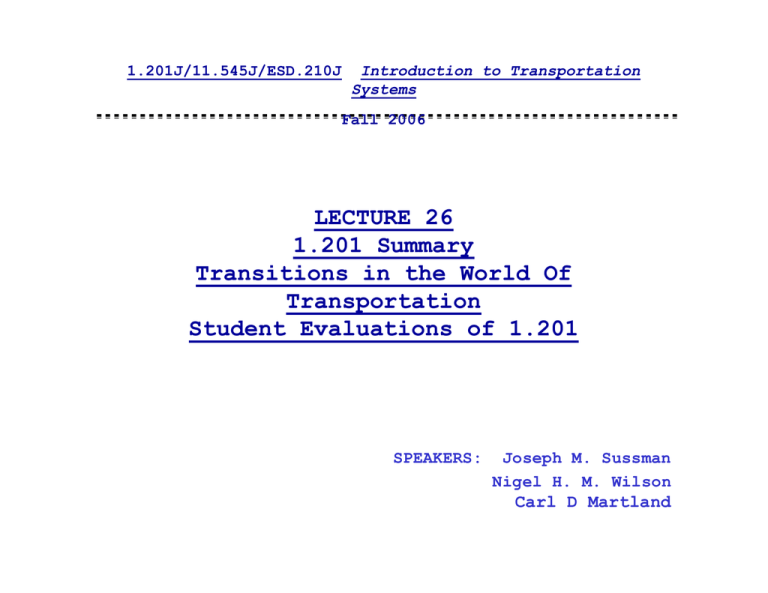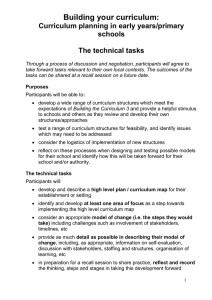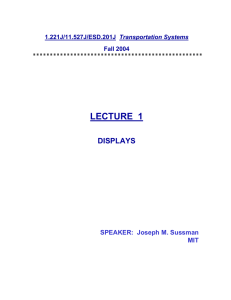LECTURE 26 1.201 Summary Transitions in the World Of Transportation
advertisement

1.201J/11.545J/ESD.210J Introduction to Transportation Systems Fall 2006 LECTURE 26 1.201 Summary Transitions in the World Of Transportation Student Evaluations of 1.201 SPEAKERS: Joseph M. Sussman Nigel H. M. Wilson Carl D Martland SO WHERE HAVE WE BEEN IN 1.201? I Concepts Transportation System Components 30 Key Points Critical Issues in Transportation Large-Scale Infrastructure: The Interstate The basics of demand modeling The basics of costing Networks 2 SO WHERE HAVE WE BEEN IN 1.201? II Traveler Transportation Automobiles Urban Form and Transportation Urban Public Transportation Intercity Traveler Transportation 3 SO WHERE HAVE WE BEEN IN 1.201? III Freight Transportation Total Logistics Costs (TLC) LOS for freight modes Operating and Investment Issues Comparison of Various Freight Modes Intermodalism 4 SO WHERE HAVE WE BEEN IN 1.201? IV Themes Project Evaluation Privatization (Public Transportation) Technology/ITS Transportation/Environment/Sustainabi lity - Mexico City Case Large Scale Infrastructure - Urban Rail - The NY City Subway System Public Policy - Highway Safety Case 5 SOME EMPHASIZED POINTS (WE CAN'T DO EVERYTHING IN SEMESTER!) ONE Transportation as a complex system The Triplet of Technology/Systems/Institutions Level-of-Service (LOS)--freight and travelers--the importance of the customer The Cost/LOS trade-off - both straightforward and subtle Supply/Demand/Equilibrium The Vehicle-cycle Transportation as a component of a larger social-political-economic system--a force for good and otherwise 6 "REAL WORLD" ABSTRACTION FRAMEWORKS MODELS ANALYSIS RESULTS/ DESIGNS COMMON SENSE PROFESSIONAL JUDGMENT PRACTICAL SOLUTION 7 TRANSITIONS IN THE WORLD OF TRANSPORTATION: A SYSTEMS VIEW Joseph M. Sussman Transportation Quarterly Vol. 56, No. 1, Winter 2002 Eno Transportation Foundation Washington, DC, 2002 8 SUMMARY OF TRANSITIONS FROM TO 1. Capital Planning → Management and Operations Focus 2. Long Timeframes → Real-time Control 3. Urban Scale Planning and Operations → Regional Scale Planning and Operations 4. Emphasis on Mobility → Emphasis on Accessibility (the Transportation/LandUse Connection) → Customer Orientation → Quality → Pricing for Service 5. “One Size Fits All" Service SUMMARY OF TRANSITIONS (CONTINUED) FROM 6. Allocate Capacity by Queuing 7. Aggregate Methods for Demand Prediction TO → Allocate Capacity by Pricing → Disaggregate Methods for Demand Prediction 8. Episodic Data for → Investment Planning Dynamic Data for Investment Planning (and Operations) 9. Public Financing for Infrastructure and Operations → Private and Public/Private Partnerships for Financing of Infrastructure and Operations Using Hybrid Return on Investment Measures 10. Infrastructure Construction and Maintenance Providers → New High-Technology Players SUMMARY OF TRANSITIONS (CONTINUED) FROM TO 11. Static Organizations and Institutional Relationships 12. Professional Emphasis on → → Dynamic Organizations and Institutional Relationships Professional Emphasis on Transportation as a Complex, Large-Scale, Integrated, Open System (CLIOS) Sustainable Development → Ubiquitous Computing → Design of Physical Infrastructure 13. Economic Development 14. Computers are "Just a Tool" 15. FROM TO AND ON TO Supply-Side Perspective Supply/Demand Equilibrium Framework Systems that Never Reach Equilibrium SUMMARY OF TRANSITIONS (CONTINUED) FROM TO 16. Independent Conventional Infrastructure Projects → Linked Advanced 17. Vehicles and Infrastructure as 18. Independent Reducing Consequences → of 19. 20. Infrastructure Projects Requiring a System Architecture Vehicles and Infrastructure as Electronically Linked → Crash Avoidance Crashes FROM TO AND ON TO Modal Perspective Intermodal Perspective Supply Chain Management Narrow Transportation Specialists → The New Transportation Professional HOPE YOU ENJOYED 1.201 GOOD LUCK ON THE FINAL! 13




